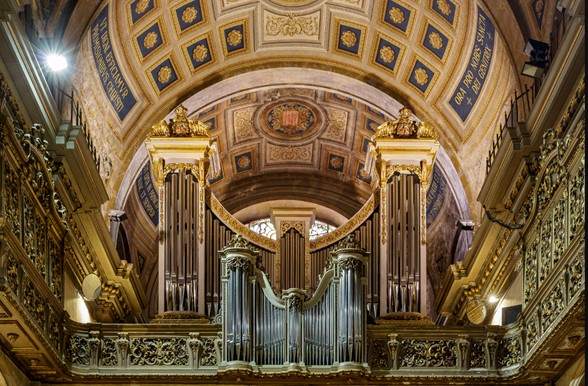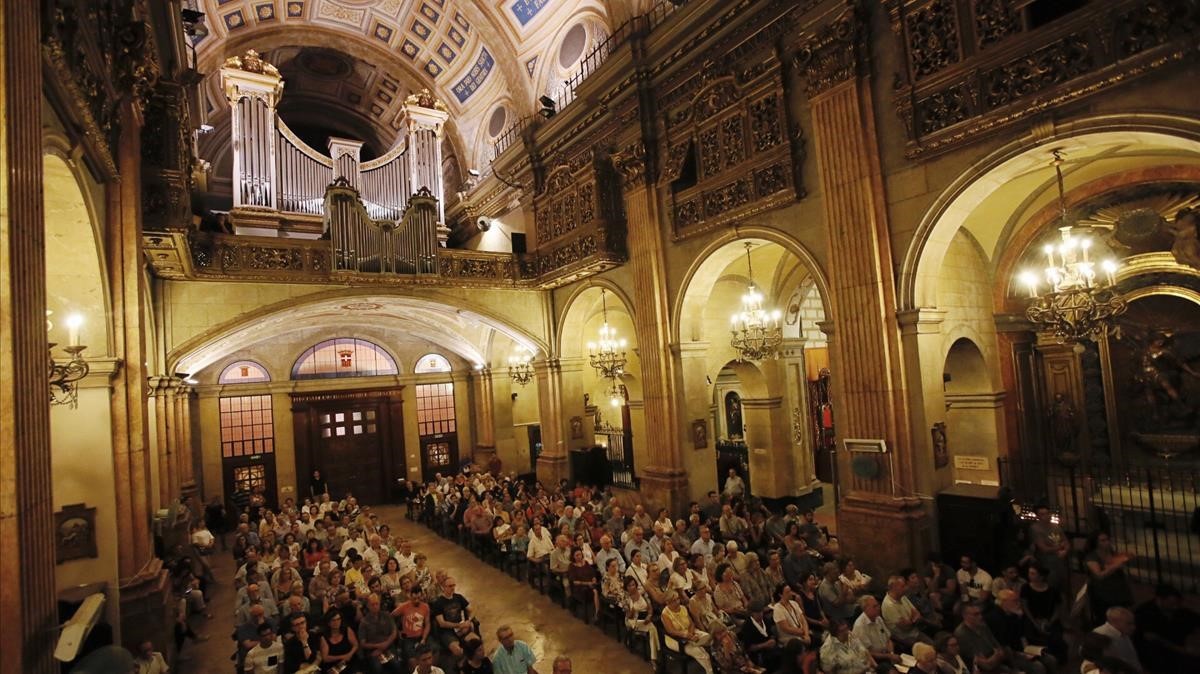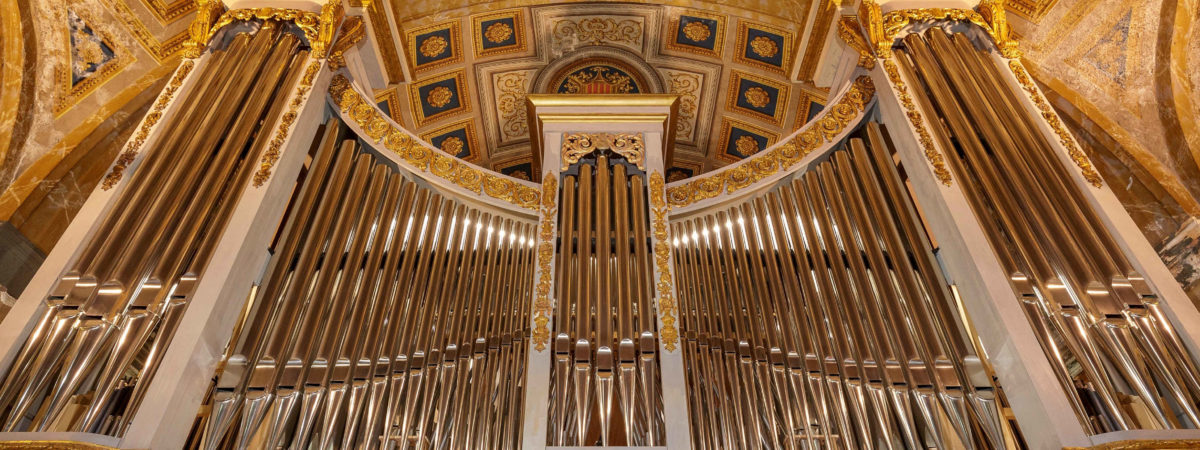En linea con la Fiesta Mayor de la Mercè, te presentamos la Basílica de la Merced
En nuestro anterior post, informábamos sobre las actividades más recomendables en torno a la celebración de la Fiesta Mayor de Barcelona. Se celebra del 20 al 24 de septiembre a raíz de la festividad de la Virgen de la Merced, patrona de la ciudad desde 1687.
En esta publicación presentamos la Basílica de Nuestra Señora de la Merced y San Miguel Arcángel (en catalán, Basílica de la Mare de Déu de la Mercè i Sant Miquel Arcàngel). Una maravillosa obra arquitectónica barroca situada en la plaza de la Merced, en pleno Barrio Gótico de Barcelona. Fue construida entre 1765 y 1775 por el arquitecto catalán José Mas Dordal.
Y queremos dar nuestro apoyo difundiendo la campaña de mecenazgo y apadrinamiento que la Basílica de la Mercè que ha conseguido recuperar su espectacular órgano de 23 registros y 1.236 tubos, y que aún está abierta a nuevas aportaciones.
¿Conoces la historia de la Basílica de la Mercè?
La actual iglesia se levanta sobre una anterior de época medieval que tuvo una ampliación en estilo gótico en los siglos XIV-XV. Pertenecía a un conjunto de iglesia y convento de la Orden Mercedaria. Con la desamortización en 1835, se convirtió primero en una escuela y, actualmente, en sede de la Capitanía General de la Cuarta Región Militar.
En 1918 recibió el título de basílica menor, otorgado por el papa Benedicto XV, en conmemoración del VII centenario de la aparición de la Virgen a san Pedro Nolasco, fundador de la Orden Mercedaria.
¿Cuáles son los elementos arquitectónicos más relevantes?
El interior de la basílica se construyó con planta de cruz latina, una nave central amplia y dos naves laterales, delante de las capillas y situadas entre los contrafuertes, de la época gótico y un transepto con cúpula sobre el crucero.
La Mercè destaca por su monumentalidad, su delicada decoración en estilo rococó, con ricos revestimientos en mármol y estuco así como complicadas celosías en las tribunas altas. La valiosa imagen de la Mare de Déu de la Mercè es una obra gótica de 1361, atribuida al escultor Pere Moragues.
La majestuosidad del órgano contrastaba con su estado precario
“El actual instrumento es obra de Cayetano Estadella, quien completó en 1941 una primera etapa con la construcción de la caja, la consola de cuatro manuales, el mueble de pared, y dos de los teclados, dejando en funcionamiento 23 registros y 1.236 tubos.
Diversas vicisitudes, como la muerte del mismo constructor en 1944 y las dificultades de la posguerra, fueron la causa de que este órgano no lograra desarrollar nunca todas las posibilidades previstas en el proyecto original.
Este órgano ha tenido varias tentativas para poder ser acabado, como la del organero y cuñado de Estadella, Pau Xuclà o la última a cargo de holandés E. Ottes quien hacia el año 2000 construyó una nueva consola de 3 teclados e instaló una transmisión mecánica sin llegar a concluir los trabajos, quedando un instrumento inacabado y caótico.
Barcelona estrena su mejor órgano coincidiendo con las Fiestas de la Mercè
El “nuevo” órgano de la Basílica de La Mercè realizado por el maestro organero Gerhard Grenzing se inaugurará oficialmente coincidiendo con las Fiestas de la Mercè de este año.
El majestuoso instrumento cuenta con tres teclados y pedalier, aproximadamente 3.000 tubos repartidos en 42 registros diferentes.
Te invitamos a asistir a los conciertos
Barcelona “Ciudad internacional de órganos”
Pocas ciudades europeas pueden disfrutar como Barcelona de un título como «ciudad internacional de órganos». Otros modelos serían, aunque con limitaciones, París y Bruselas. Desde el siglo XIV la ciudad condal ha sido el punto de encuentro de maestros venidos desde Alemania, Flandes, Francia y Suiza que han intercambiado sus conocimientos con los organeros locales.
Fruto de ello, ha sido la escuela organera catalana con obras excepcionales en tamaño y recursos musicales muy desarrollados ya desde el siglo XVI. Otro ejemplo de gran importancia es el instrumento de Johann Spinn von Neuern en la basílica de Santa María del Mar en Barcelona en torno a 1480; y la fachada del órgano de la catedral con sus grandes tubos que datan del 1539, obra del maestro Pere Bordons (1547) y sus compañeros Peris Arrabasa y Fermin Granollers.
El órgano de la Mercè se perdió en la guerra civil, había sido creado a finales del siglo XVIII por Jean-Pierre Cavaillé, fundador en Barcelona de la dinastía Cavaillé Coll, y posterior exponente y referencia para los órganos románticos del siglo XIX a escala mundial[1].
Quieres dejar tu huella en Barcelona? Aún puedes apadrinar un tubo del órgano de la Mercè
El nuevo órgano de La Mercè ha sido posible gracias al apoyo de la Fundación «la Caixa», a la Generalitat de Catalunya y a donativos de particulares y empresas que han querido dejar su huella en Barcelona y mostrar su apoyo a la cultura y a la música.
Los tubos se pueden apadrinar a partir de tan sólo 50 €. A cambio de su contribución, a los padrinos y madrinas se les ofrece:
- La satisfacción de dejar su huella en el corazón de Barcelona
- El listado completo de donantes figurará en una placa cuando el órgano esté acabado
- El mismo listado se esconderá en la «Cápsula del tiempo» donde se incluirán diferentes materiales que documentarán el proceso de construcción del nuevo órgano.
Consulta toda la información aquí
¿Te vas a perder un concierto de órgano en la Basílica de la Mercè?
Te recomendamos especialmente la visita nocturna y concierto de órgano del próximo día 14 de septiembre a las 20.30, todo un lujo que te hará disfrutar en todos los sentidos.
Consulta en este enlace todas las posibilidades de visitas guiadas que te ofrece la Basílica de la Mercè.
Para más información y compra de entradas clica aquí
http://www.basilicadelamerce.es/es/Hermandad-Mare-de-D%C3%A9u-de-la-Merc%C3%A8/El-%C3%B3rgano.html





